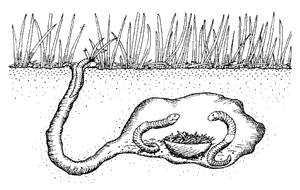Add Organic Matter In Lawn's Soil
Why You Add Organic Matter
If you have a healthy turf and soil you might think that the soil would be able to generate its own organic content. That is only partially true.
IF the soil is not compacted and the grass roots grow full and deep and IF you have a large population of earthworms and microbes, then the organic levels of the soil are raised by the addition of dead roots and dead earthworms and dead microbes. Roots, earthworms, and microbes are constantly recreating themselves and dying.
Truly healthy soil has between 3% and 5% organic material. That level can be maintained ONLY IF you add organic matter to the soil at the surface year in and year out. The plants, the earthworms, and the microbes need that additional matter to sustain a healthy soil. In the woods and prairies, that added organic matter came from dead leaves or dead grasses decomposing each year. We need to replicate that process in our lawns to be able to maintain a healthy organic content in our soil.
But few residential landscapes have soil this rich with organic material. The reality is that the soil under American lawns typically contains less than 1% organic material. This is because over a ten or twenty year period not only was no new organic material introduced, but the most abundant natural sources such as leaves and grass clippings were systematically collected and disposed of in the municipal trash stream.
A healthy soil needs a steady source of new organic material. It is constantly decomposing and yielding nutrients for the grass plants and must be replaced. The black fibrous material (called "humus") that results from the decomposition of grass clippings and other organic material eventually has little food value left. However, it has enormous value in aerating the soil, in storing water, and in feeding key microorganisms needed for other tasks.
While leaving grass clippings on the lawn provides some organic material, it is not sufficient to consistently provide 3 or 5 %. You must provide more.

How Organic Matter Enters the Soil
When you mulch the lawn by leaving grass clippings and chopped leaves when you mow, this organic material eventually begins to decompose. More important, the earthworms seek it out and pull it down into the soil and eat it.
As they go about their business in the soil under your lawn they excrete their weight in nutrient rich castings every day. In a 1000 sq. ft. lawn, for example, a population of just 5 worms per cubic foot (considered a low population) will give your lawn over 150 pounds--about 1/3 pound per worm--of top-grade fertilizer during each growing season.
Worms not only produce this valuable fertilizer, they also spread it evenly throughout the top 12 inches of the soil. In many cases they travel much deeper, sometimes as far down as 6 feet. This upper layer of rich soil, called topsoil, is where most plant roots and micro-organisms reside.
Mulching Reduces Soil Compaction
Mulching is a good way to assure that the soil under turfgrass resists compaction that normally occurs from the weight of foot traffic and yard care equipment. If it contains the desirable 3% to 5% organic matter in its top 8 to 12 inches, soil will have more air in it. Because organic matter, whatever its type has a spongy, loose texture, when it is introduced into soil, it creates pore spaces between its particles, lightening its texture. This is especially helpful in clay soils. Plant roots can penetrate this soil more easily and grass is healthier.
Mulching Improves Soil Moisture
The soft, loose texture of the organic matter in a lawn mulch improves the ability of the soil to both hold moisture and drain away excess water. When organic matter is incorporated into the top layer of the soil by the earthworms its particles act like miniscule sponges, absorbing and holding moisture right in the zone where plant roots are growing. When they are fully moist, any overflow moisture flows through the improved air spaces past the roots down into the water table. Because of this virtue, mulching is particularly useful to enhance water retention of sandy soils.
Mulching Improves the Grass
If you do not routinely mulch your lawn with organic matter, it’s high time to begin. While it is an extra task, it pays big dividends. It contributes to the development of healthy soil by stimulating soil life to provide nutrients and by loosening soil structure so that it holds air and moisture.
Healthy soil translates into healthier grass. Growing in soil with sufficient organic content grass plants can expand their considerable root systems, penetrating deeply into the soil to tap more dependable supplies of water and nutrients. They are more self-reliant, less dependent on us for nutrition and moisture. They do not suffer stress. The result is fewer problems with weeds, diseases and pests.
